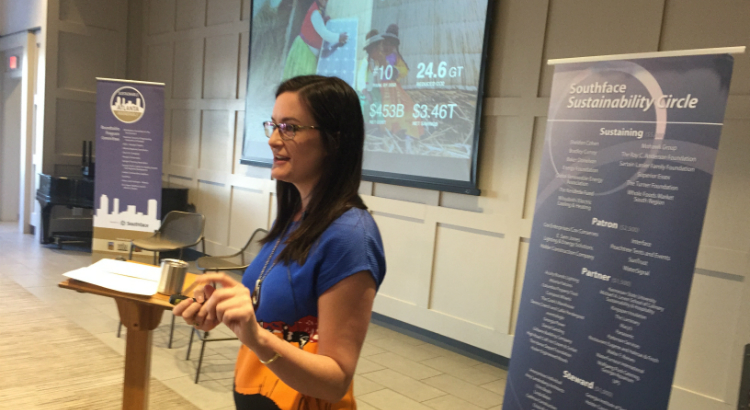What’s the most significant step humans could take over the next few decades to reverse climate change?
”Refrigerant management,” according to a high-profile campaign to focus on solutions to the global problem.
That sexy tidbit comes to us via Project Drawdown — an initiative led by sustainability advocate Paul Hawken. With such books as The Ecology of Commerce and Natural Capitalism, Hawken has had a significant impact over the last three decades on the way business leaders think about the environment.
At this morning’s Sustainable Atlanta Roundtable, another author offered up a preview to an upcoming book on Project Drawdown. Drawdown: The Most Comprehensive Plan Ever Proposed to Reverse Global Warming is set for release next month. Katharine Wilkinson was lead writer on the book, which Hawken edited.
“We think so much about global warming as a problem, and indeed it is,” Wilkinson told the audience of about 120. “But it is also an opportunity to reimagine and rewire our world.”
Hawken, Wilkinson and others involved in Project Drawdown spent near four years assembling data on the world’s 100 “most substantive” potential climate solutions. The book is meant to draw widespread attention to the possible impact of each of those measures.
“Refrigerant management” was the highest ranking of all because of the powerful greenhouse effect of hydrofluorocarbons, which are used as refrigerants in equipment ranging from air conditioning to freezers. HFCs are less harmful to the ozone layer than were an earlier, now-banned generation of refrigerants. But HFCs are up to 9,000 times as efficient as carbon dioxide at trapping heat inside the atmosphere. A global agreement negotiated last fall in Kigali, Rwanda, will phase HFCs off the market over the next decade. But the big challenge will be to dispose of them in a way that prevents their escape into the atmosphere.
Controlling the emissions would generate a enormous climate payoff: It could prevent the equivalent of nearly 90 billion metric tons of carbon dioxide from wafting into the upper atmosphere by 2050.
“Scientists estimate the Kigali accord will reduce global warming by nearly one degree Fahrenheit,” according the Drawdown website.
Not surprisingly, a large portion of the 100 solutions involve the built environment. Fifteen are grouped together under “Buildings and Cities,” and 20 are classified under “Energy.” Add in another dozen or so that fall in the Food, Materials and Transport categories, and nearly half the solutions end up being related to buildings and infrastructure. (“Living Buildings” even makes the list as a “Coming Attraction” — meaning the potential impact of the Living Building Challenge proved too difficult to quantify.)
Wilkinson stressed that Drawdown is built on the conviction that empowering people with information for positive change can help people tackle climate change. “The dominant narrative about human beings and climate change, is that we’re horrible, no good … and on and on,” she said. “And frankly that is a narrative for good reason.”
But, she added, an “alternative narrative” is needed: “The work confirms that there are reasons for courage and active hope — that it’s not ‘game over’ for climate change, as some would say, and it’s actually ‘game on.’”


